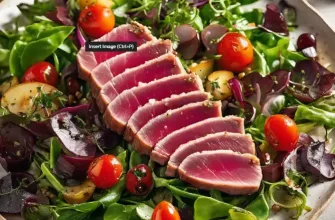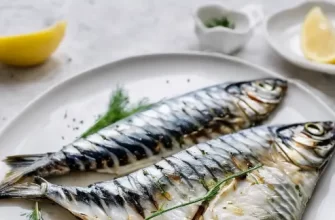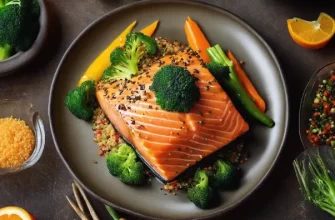Are you an aqua-gourmet searching for a nutritious and tasty fish to include in your diet? Out of the numerous varieties of fish available in the market, one is making a splash in culinary circles. Care to take a guess? It’s trout!
Owing to its incredible taste and incredible health benefits, trout is rapidly acquiring a spot on discerning dining tables worldwide.
Let’s dive deeper and fish out the reasons why trout is a delectable and healthful option for fish lovers.
1. Packed With Nutrients
Trout is an impressive source of various essential nutrients. One standard serving of trout (around 3 ounces) provides you with essential nutrients such as protein, vitamins, and minerals. The table below breaks down the nutritional content of trout.
| Nutrient | Amount in 3 ounces of cooked trout |
|---|---|
| Calories | 144 |
| Protein | 20g |
| Total Fat | 6g |
| Saturated Fat | 1g |
| Omega-3 Fatty Acids | 1g |
2. Rich Source of Omega-3 Fatty Acids
Owing to the considerable presence of Omega-3 fatty acids in trout, it is an excellent choice for heart health. Regular intake of Omega-3 fatty acids is correlated with a decreased risk of cardiovascular diseases. They also foster brain health, enhancing memory and cognitive functions.
3. Proteins Galore!
Trout is an excellent source of high-quality protein, with one serving providing about 20 grams. Proteins foster growth and maintenance of body tissues and boost satiety levels, making it a great choice for people aiming to manage their weight.
4. Variety of Cooking Methods

There’s no denying that trout’s versatility in cooking is another reason that makes it a favorite. Whether you fancy grilling it, frying it, or baking it, trout adapts to a wide array of cooking methods. It also easily absorbs the flavors of seasonings and marinades, enriching the overall taste of the dish.
5. Environmental Impact
Trout, specifically rainbow trout, is often farm-raised. This not only provides a more controlled environment for growth but also helps to minimize the environmental impact of overfishing. However, it is advisable to source trout from farms that follow sustainable practices.
FAQ
Q: Is trout a healthy fish to consume?
A: Yes, trout is considered a nutritious and healthy choice. It is a rich source of protein, omega-3 fatty acids, and essential minerals such as potassium and selenium.
Q: How should I store fresh trout?
A: If you have purchased fresh trout, it is best to store it in the coldest part of your refrigerator. Place it in a sealed container or wrap it tightly in plastic wrap to prevent any odors from spreading.
Q: Can I freeze trout for later use?
A: Absolutely! If you have excess trout or want to store it for a longer period, freezing is a great option. Make sure to properly clean, wrap it in moisture-proof packaging, and label it with the date to maintain quality.
Q: What is the best way to prepare trout?
A: Trout can be prepared in various ways, based on personal preference. A popular and simple method is to pan-fry it with a little oil and seasonings. Grilling, baking, and smoking are also delicious options that retain the fish’s natural flavors.
Q: Are there any specific spices or herbs that go well with trout?
A: Trout has a delicate flavor, so it pairs well with milder seasonings such as lemon zest, dill, parsley, and garlic. Experimenting with different herbs and spices can help you discover your preferred flavor combination.
Q: Should I remove the skin before cooking trout?
A: The decision to remove the skin depends on personal preference. Some people enjoy the crispy texture that the skin adds, while others prefer the flesh without it. If you choose to leave it on, make sure to clean the skin thoroughly before cooking.
Q: How do I know when trout is cooked properly?
A: Trout is cooked when the flesh turns opaque and easily flakes with a fork. It should reach an internal temperature of 145°F (63°C). Overcooking can result in dry and less flavorful fish.
Q: Can I eat trout raw or partially cooked like sushi?
A: Eating raw or partially cooked fish carries a risk of foodborne illnesses due to potential parasites and bacteria. It is recommended to cook trout thoroughly to eliminate any health risks.
Q: Are there any bones in trout that I should be aware of?
A: Yes, trout contains small, sharp bones that are typically removed during the cleaning process. However, it is always a good idea to double-check for any remaining bones before consuming the fish.
Q: Where can I purchase fresh trout?
A: Fresh trout can be found at local fish markets, seafood stores, or even some supermarkets. Alternatively, you can consider fishing for trout yourself in lakes, rivers, or streams, depending on local fishing regulations.
Q: Are there any sustainability concerns with eating trout?
A: Trout farms that follow sustainable practices can be a good choice, as they minimize negative environmental impact. Look for labels like “certified sustainable” to ensure your trout was responsibly sourced.
Conclusion
The answer to ‘Is Trout a good fish to eat?’ is a resounding yes! Savoring trout can be an ideal way to satiate your seafood cravings while nourishing your body with essential nutrients. Just be mindful of its source and how it’s prepared, and you can reap the benefits this fish has to offer!
Before you head out to fetch some trout, please note that it belongs to the same family as salmon, and hence, those allergic to salmon might be allergic to trout as well. If you have any allergies or dietary restrictions, consult your healthcare provider before introducing new foods to your diet. Feast responsibly and enjoy your trout!









